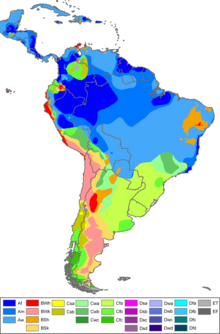Arid Diagonal

The Arid Diagonal (Spanish: diagonal árida/arreica) is a contiguous zone of arid and semi-arid climate that traverses South America from coastal Peru in the Northwest to Argentine Patagonia in Southeast including large swathes of Bolivia and Chile.[1] The Arid Diagonal encompasses a number of deserts, for example: Sechura, Atacama, Monte and the Patagonian Desert.
The Arid Diagonal acts to isolate the temperate and subtropical forests of Chile and southern Argentina from other forests of South America.[2]
Cause and origin
The Arid Diagonal is a result of the locking of the South Pacific High caused by the barrier the Central Andes constitutes[3] and the rain shadow the Southern Andes casts over eastern Patagonia.[1] South of Mendoza (32°53' S) the driest parts of the diagonal move away from the Andes as the mountains lose height causing some humidity to penetrate, thus at more southern latitudes the driest parts lie on the Atlantic coast of Patagonia.[1]
The origin of the aridity of northern part of the diagonal is linked to two geologic events: a) the rise of Andes—an event that led to the permanent block of the westward flow of moisture along the tropics and b) the permanent intrusion of cold Antarctic waters along South Americas west coast.[3]
References
- ^ a b c Bruniard, Enrique D. (1982). "La diagonal árida Argentina: un límite climático real". Revista Geográfica (in Spanish): 5–20.
{{cite journal}}:|access-date=requires|url=(help) - ^ Villagran, Carolina; Hinojosa, Luis Felipe (1997). "Historia de los bosques del sur de Sudamérica, II: Análisis fitogeográfico". Revista Chilena de Historia Natural (in Spanish). 70: 241–267.
{{cite journal}}:|access-date=requires|url=(help) - ^ a b Armesto, Juan J.; Arrollo, Mary T.K.; Hinojosa, Luis F. (2007). "The Mediterranean Environment of Central Chile". In Veblen, Thomas T.; Young, Kenneth R.; Orme, Anthony R. (eds.). Physical Geography of South America. Oxford University Press. pp. 184–199.
